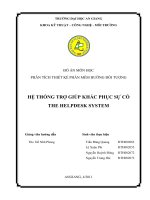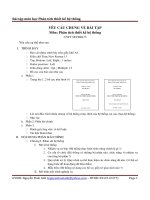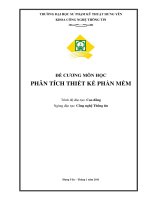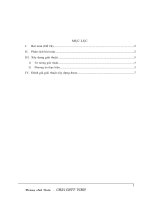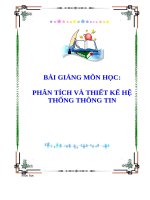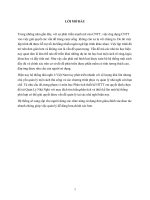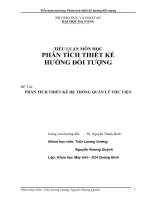Dynamic programming (slides) + full môn học Phân tích Thiết kế thuật toán Nguyễn Thanh Sơn
Bạn đang xem bản rút gọn của tài liệu. Xem và tải ngay bản đầy đủ của tài liệu tại đây (911.79 KB, 30 trang )
DYNAMIC
PROGRAMMING dp
DESIGN AND ANALYSIS OF ALGORITHMS
LECTURER: Nguyễn Thanh Sơn
CS112.L23.KHCL.N12
The shortest path
4
A
D
18
11
1
9
2
S
B
5
13
E
16
2
5
C
T
F
2
Apply the Greedy approach, the shortest path from S to T is?
The shortest path
The Greedy approach can not be applied to this case:
(S, A, D, T)
1+4+18=23
The real shortest path is:
(S, C, F, T)
5+2+2=9
So today we will learn about a new algorithm
CONTENT
1.
2.
3.
4.
5.
6.
What is Dynamic Programming?
Characteristics of Dynamic Programming
Dynamic Programming Methods
Compare with other algorithms
Steps in Dynamic Programming
List of Dynamic Programming Problems
1. What is Dynamic programMing?
Dynamic programming (DP) approach is similar to Divide and
Conquer in breaking down the problem in smaller and yet
smaller possible sub-problems.
But unlike Divide and Conquer, results of these smaller subproblems are remembered and used for similar or overlapping
sub-problems.
2.
Characteristics of Dynamic
Programming
Overlapping Subproblems
Optimal Substructure
Overlapping Subproblems
There exist some places where we solve the
same subproblem more than once
EX:
DP:
Optimal Substructure
The optimal solution to the problem contains
within optimal solutions to its subproblems.
EX:
3
S
1
2
A
4
7
B
T
5
5
dmin (S, T) =
=
=
6
dmin(S, A) + dmin(A, B) + dmin(B, T)
1+2+5
8
Dijkstra
3. Dynamic Programming Methods
DP offers two methods to solve a problem:
Top-down with Memoization
Bottom-up with Tabulation
3. Dynamic Programming Methods
Top-down with Memoization
f5
f3
f1
f4
f2
f2
f0
f1
f0
f3
f2
f1
f0
f1
f1
MemoRization
In this approach, we try
to solve the bigger problem by
recursively finding the solution to
smaller sub-problems. Whenever
we solve a sub-problem, we cache
its result so that we don’t end up
solving it repeatedly if it’s called
multiple times. Instead, we can just
return the saved result. This
technique of storing the results of
already solved subproblems is
called Memoization.
3. Dynamic Programming Methods
Top-down with Memoization
f5
f3
f1
f4
f2
f2
f0
f1
f0
f3
f2
f1
f0
f1
f1
F=[]
O(n)
def Fib(n):
if n in F:
return F[n]
if (n < 2):
return 1
result = Fib(n-2) + Fib(n-1)
F[n] = result
return result
3. Dynamic Programming Methods
Bottom-up with Tabulation
Tabulation is the opposite of
the top-down approach and avoids
recursion. In this approach, we solve
the problem “bottom-up” (i.e. by
solving all the related sub-problems
first). This is typically done by filling up
an n-dimensional table. Based on the
results in the table, the solution to the
top/original problem is then
computed.
f5
f3
f1
f4
f2
f2
f0
f1
f0
f3
f2
f1
f0
f1
f1
3. Dynamic Programming Methods
Bottom-up with Tabulation
f5
f3
O(n)
def Fib(n):
F[0] = 0
F[1] = 1
for i in 2...n
F[i] = F[i-2] + F[i-1]
return F[n]
f1
f4
f2
f2
f0
f1
f0
f3
f2
f1
f0
f1
f1
Comparison
Top-down with Memoization
Bottom-up with Tabulation
Easy to set up
Gets complicated if there are
multiple conditions
Must be solved from the top down
Must be solved from the bottom up
Slower due to recursion
Faster, due to direct access to the
results stored in the table
Just solve the necessary problems
Must solve all subproblems
4. Compare with other algorithms
Dynamic programming vs Greedy method
Dynamic programming
DP are motivated for an overall
optimization of the problem
Greedy method
Local optimization is addressed
Dynamic programming
Greedy method
1. Dynamic Programming is used to obtain the optimal 1. Greedy Method is also used to get the optimal
solution.
solution.
2. In Dynamic Programming, we choose at each step, 2. In a greedy Algorithm, we make whatever choice
but the choice may depend on the solution to sub- seems best at the moment and then solve the subproblems.
problems arising after the choice is made.
3. Less efficient as compared to a greedy approach
3. More efficient as compared to a greedy approach
4. Example: 0/1 Knapsack
4. Example: Fractional Knapsack
5. It is guaranteed that Dynamic Programming will 5. In Greedy Method, there is no such guarantee of
generate an optimal solution using Principle of getting Optimal Solution.
Optimality.
4. Compare with other algorithms
Dynamic programming vs Divide and Conquer
Dynamic Programming
DP use the output of a smaller subproblem and then try to optimize a
bigger sub-problem and use
Memoization to remember the
output of already solved subproblems.
Divide and Conquer
Solutions are combined to achieve
an overall solution
Dynamic programming
Divide and Conquer
1. It involves the sequence of four steps:
Characterize the structure of optimal solutions.
Recursively defines the values of optimal solutions.
Compute the value of optimal solutions in a
Bottom-up minimum.
Construct an Optimal Solution from computed
information.
1. It deals (involves) three steps at each level of
recursion:
Divide the problem into a number of subproblems.
Conquer the subproblems by solving them
recursively.
Combine the solution to the subproblems into the
solution for original subproblems.
2. It is non Recursive.
2. It is Recursive.
3. It solves subproblems only once and then stores in
the table.
3. It does more work on subproblems and hence has
more time consumption.
4. It is a Bottom-up approach.
4. It is a top-down approach.
5. In this subproblems are interdependent.
5. In this subproblems are independent of each other.
6. For example: Matrix Multiplication.
6. For example: Merge Sort & Binary Search etc.
Dynamic Programming
Paradigm
Methodology
Overlapping
Subproblems
Divide and
Conquer
AND
Optimal
Substructure
Memoization
Top-down
approach
OR
Tabulation
Bottom-up
approach
5.
1.
2.
3.
4.
Steps in Dynamic Programming
Characterize structure of an optimal solution.
Define value of optimal solution recursively.
Compute optimal solution values either top-down with caching or
bottom-up in a table.
Construct an optimal solution from computed values.
6. List of Dynamic Programming
Problems
1.
2.
3.
4.
5.
6.
7.
8.
Kadane’sao Algorithm
0 1 Knapsack Problem
Longest Increasing
Subsequence Problem
Edit Distance Problem
Integer Knapsack Problem
Fibonacci Numbers Problem
Rod Cutting Problem
Subset Sum Problem
9. Coin change Problem
10. Treats for the Cows
You can find more Dynamic
Programming problems here.
0-1 Knapsack Problem
Matrix Chain Multiplication
KAHOOT!
